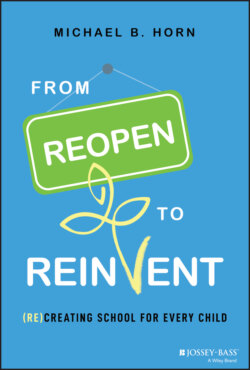Читать книгу From Reopen to Reinvent - Michael B. Horn - Страница 38
A STARTING POINT FOR THE PURPOSE CONVERSATION
ОглавлениеSchools can tackle this work in different ways. The “tools of cooperation” framework that Chapter 11 explores shows that when a school community doesn't have alignment around what it wants or how to get there, public school leaders are limited in the tools they can use to create forward progress and change. If leaders can help stakeholders rally around a shared vision for the purpose of schooling, then they will have more tools from which they can draw.
One way to create a shared vision is to engage in the common exercise of constructing a portrait of a graduate.8 The idea is to sketch what an individual entering the world in some number of years would need to be prepared to lead a choice-filled and civically engaged life.
When I have mentioned the importance of doing this sort of work, some have pushed back. They have said that starting with a blank slate when so many educators and school communities have already done great work on the portrait of a graduate exercise seems like reinventing the wheel—often in the name of a purposeless local control. This can be true. Yet going through the process is valuable. It can create consensus and clarify genuine differences in viewpoints.
Although the headlines from such an exercise may be roughly the same, the nuances and what it will specifically take to fulfill a school's purpose will differ. That's why it's critical to not just make high-level statements about a school's purpose, but also to make clear how you would know if your school was successful in this pursuit. What are the goals and how would you measure them? Yes, government agencies require that public schools measure certain outcomes, but schools should also figure out what's important to them and then identify specific metrics to indicate whether they are on the right track. Specificity and clarity are important.
To this point, this is a conversation that shouldn't just happen at the individual school level. It's one that should happen at all different levels, from states to districts and from charter management organizations to individual schools. Public educators are quick to point out that their autonomy is limited because of regulations that mandate they teach certain subjects, standards, and courses. Even in states that have created pathways for mastery-based, or competency-based, learning, they still often require that students take certain numbers of course credits in different subjects, for example. In many cases, portraits of a graduate at a state level are more aspirational than actionable. Still, the conversation is an important start to clarifying the destination.
